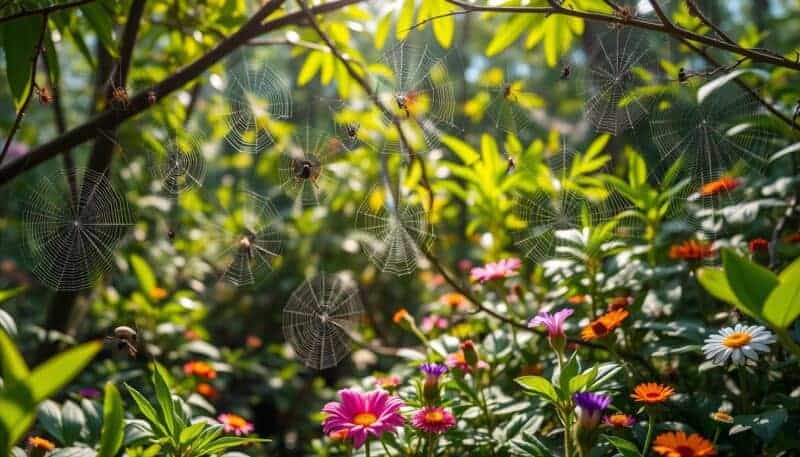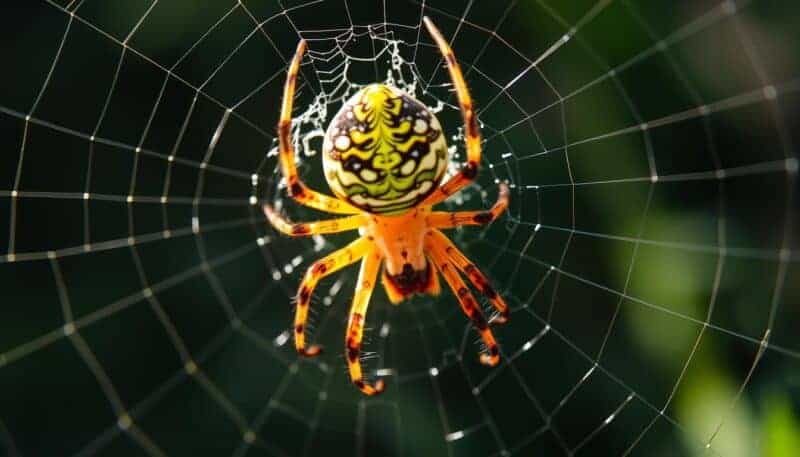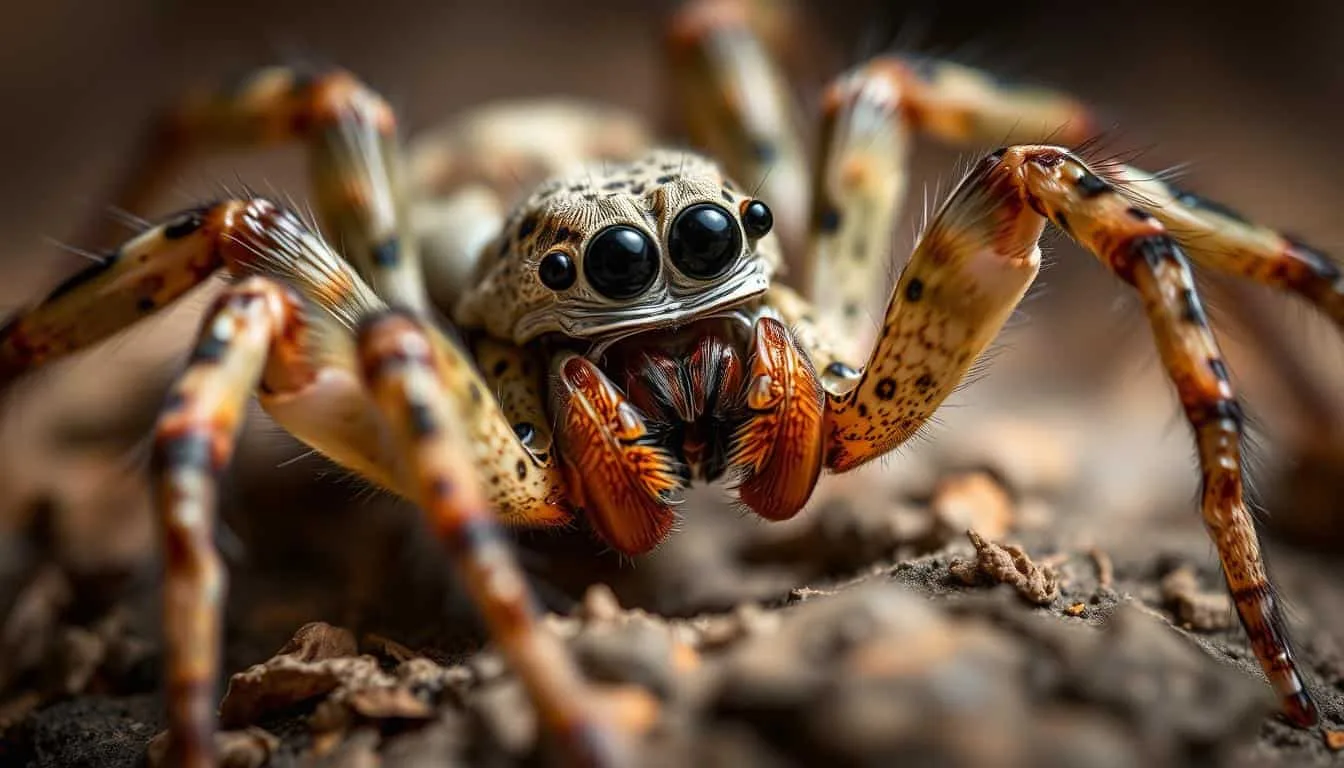Introduction
Did you know there are over 45,000 known spider species worldwide? These eight-legged creatures are found almost everywhere, from cities to wilderness. Spiders are important in ecosystems, controlling pests and shaping food chains.
In this guide, we’ll explore the world of spiders. We’ll look at their anatomy, behaviors, and roles in ecosystems. Get ready to be amazed by these eight-legged wonders and their importance in our world.
- What's a Spider: Understanding These Fascinating Arachnids
- The Remarkable Anatomy of Eight-Legged Creatures
- Spider Body Structure and Functions
- How Spiders Create and Use Their Silk
- Feeding Habits and Hunting Techniques
- Spider Habitats and Distribution Worldwide
- The Role of Spiders in Ecosystem Balance
- Spider Species and Their Unique Characteristics
- Conclusion
- FAQ:
What’s a Spider: Understanding These Fascinating Arachnids
Spiders are a captivating group of arachnids. They are often mistaken for insects but have unique features. As skilled insect hunters, they play a key role in the ecosystem. They control pest populations and keep the natural world balanced.
Differences Between Spiders and Insects
Both insects and spiders are arthropods. However, they differ. Spiders have eight legs and two body parts. Insects have six legs and three body parts. Spiders also have fangs and venom glands for catching prey, unlike insects.
Classification of Spiders in the Animal Kingdom
Spiders belong to the Arachnida class, along with scorpions and mites. Within Arachnida, spiders are part of the Araneae order. This order has many families and species, each with its own traits.
Common Misconceptions About Spiders
- Spiders are not insects, but rather bugs with fangs that belong to the arachnid class.
- Not all spiders are venomous, and the majority pose no threat to humans.
- Spiders are generally not aggressive and will only bite in self-defense or when accidentally disturbed.
- Spiders play a crucial role in the ecosystem by controlling insect populations and serving as an important food source for other animals.
By understanding spiders, we can appreciate these fascinating arachnids. We can also clear up common misconceptions about them.
The Remarkable Anatomy of Eight-Legged Creatures
Spiders, as eight-legged creatures, have a unique anatomy. This makes them stand out from other arthropods. Their impressive physical traits help them survive and hunt effectively.
At the center of a spider’s body is its cephalothorax. It combines the head and thorax into one. Inside, you’ll find the spider’s vital organs like the nervous, digestive, and respiratory systems.
Eight long, segmented legs emerge from the cephalothorax. Each leg has a sharp claw and sensitive hairs. These help the spider move and find prey.
The spider’s abdomen, or opisthosoma, is the second part of its body. It holds the reproductive organs and the spinnerets. These are used to make the webs that many spiders are known for. The abdomen also has venom glands for catching and eating prey.
Spiders’ anatomy shows their amazing adaptations over millions of years. These eight-legged creatures thrive in many environments. They play a key role in keeping ecosystems balanced worldwide.
Spider Body Structure and Functions
Spiders, known as “bugs with fangs,” have a unique body structure. This structure helps them survive and hunt. Let’s explore the main parts of a spider’s body and how they work.
The Cephalothorax and Its Components
The cephalothorax is the front part of a spider’s body. It combines the head and thorax. Inside, you’ll find the venomous fangs, venom glands, and chelicerae.
It also has the spider’s eyes, central nervous system, and digestive system. These parts are key to the spider’s survival and hunting.
Abdomen Features and Purpose
Abdomen is the rear part of the spider’s body. It’s where the silk-producing spinnerets are found. These spinnerets help spiders make their webs.
The abdomen also has the reproductive organs and book lungs. These help with breathing and reproduction.
Understanding Spider Legs and Joints
- Spiders have eight legs with special joints and segments. This lets them move well and catch prey.
- The femur, patella, tibia, metatarsus, and tarsus are the main leg parts. Each has a unique role.
- Spiders use their tarsi to grip and move around. This makes them very agile.
Knowing about spiders’ body parts helps us understand these fascinating creatures. From the cephalothorax to the abdomen and legs, spiders have amazing adaptations.
| Body Part | Function |
|---|---|
| Cephalothorax | Houses the venom glands, fangs, chelicerae, eyes, nervous system, and digestive system. |
| Abdomen | Contains the silk-producing spinnerets, reproductive organs, and book lungs. |
| Legs | Composed of various segments (femur, patella, tibia, metatarsus, tarsus) that enable efficient movement and prey capture. |
How Spiders Create and Use Their Silk
Spiders are known for their amazing ability to make and use silk. This has fascinated scientists and the public alike. They use their silk for many things, like making webs and catching prey.
Spider silk is a natural wonder. It’s made of proteins and is very strong, yet light and flexible. Spiders have special glands for making different kinds of silk, each with its own job.
- Dragline silk: This is the strongest silk used for web frames and the spider’s lifeline.
- Capture silk: This silk is sticky and traps prey in the web.
- Egg case silk: Spiders use it to keep their eggs safe.
- Wrapping silk: This silk wraps prey, making it easier for the spider to eat.
Building a web is a remarkable feat. Spiders carefully plan and make their webs. They use their silk to create complex patterns that help them catch prey. The variety of webs shows how amazing spider silk is.
| Spider Species | Web Type | Silk Usage |
|---|---|---|
| Garden Spider | Orb-shaped | Capture prey, create structural framework |
| Funnel-web Spider | Sheet | Trap prey, construct retreat |
| Trapdoor Spider | Burrow with a hinged door | Line burrow, create trap door |
Spider silk’s versatility has inspired scientists. They’re looking into its uses in fields like medicine and textiles. Learning more about spiders helps us appreciate their role in nature.
Feeding Habits and Hunting Techniques
Spiders are skilled insect hunters and venomous arthropods. They have many ways to catch prey. Their hunting methods show their cleverness and adaptability.
Web-Building Strategies
Many spiders are famous for their web-making skills. They build different types of webs, like orb-webs and sheet webs. These webs help them catch insects and small prey.
Prey Capture Methods
- Some spiders wait patiently in ambush to catch their prey. They hide in spots where they can surprise their victims.
- Jumping spiders are very agile. They jump to catch their prey, showing off their hunting skills.
Venom Use and Digestion
Spiders use their venom to catch and digest prey. When they bite, their venom paralyzes the prey. Then, they break down the prey’s tissues with digestive enzymes.
| Hunting Technique | Description | Spider Examples |
|---|---|---|
| Web-building | Constructing intricate webs to trap prey | Orb-web spiders, funnel-web spiders |
| Ambush Predation | Waiting in concealed locations to attack prey | Crab spiders, tarantulas |
| Active Hunting | Chasing and pouncing on prey | Jumping spiders, wolf spiders |
Spiders’ hunting methods and eating habits show their amazing adaptations. They use webs, ambush, and active hunting to catch prey. These eight-legged creatures have evolved to succeed in many environments.
Spider Habitats and Distribution Worldwide
Spiders, as crawling arachnids and predatory invertebrates, live in many places around the world. They can be found in rainforests, deserts, and more. Their ability to adapt shows their strength and flexibility.
Spiders are on every continent except Antarctica. The warmest places have the most kinds of spiders. Rainforests are perfect for them because of the food and places to hide.
But spiders can also live in cooler places. They do well in forests, grasslands, and even cities. They like gardens, parks, and buildings.
| Habitat Type | Common Spider Species | Adaptations |
|---|---|---|
| Rainforests | Orb-Weaver Spiders, Jumping Spiders | Camouflage, web-building skills, agility |
| Deserts | Tarantulas, Trapdoor Spiders | Burrowing ability, heat tolerance, water conservation |
| Urban Areas | Cobweb Spiders, House Spiders | Adaptability to human-made structures, scavenging skills |
Spiders can live almost anywhere. This lets them play a big role in keeping ecosystems balanced. They are truly amazing creatures.

The Role of Spiders in Ecosystem Balance
Spiders are more than just fascinating or frightening creatures. They are key to keeping our ecosystems in balance. As insect hunters and predatory invertebrates, they help control pests and keep food chains healthy.
Natural Pest Control Benefits
Spiders are fierce insect hunters, attacking many pests that harm crops, gardens, and homes. Their quick adaptation and specific hunting skills make them great at controlling pests. By eating different insects, spiders keep the ecosystem balanced, reducing the need for harmful pesticides.
Impact on Local Food Chains
As predatory invertebrates, spiders are vital in local food chains. They link different levels of the food chain, passing energy and nutrients from insects to birds, small mammals, and amphibians. This connection keeps the ecosystem stable and resilient, showing how important spiders are.
| Ecosystem Service | Contribution of Spiders |
|---|---|
| Pest Control | Spiders are highly effective insect hunters, controlling the populations of various pests that can threaten agricultural crops, gardens, and homes. |
| Food Chain Dynamics | As predatory invertebrates, spiders play a vital role in the transfer of energy and nutrients within local food chains, supporting the overall stability and resilience of the ecosystem. |
Understanding spiders’ role in ecosystem balance helps us appreciate them more. We can work towards a better coexistence with these important creatures in our environments.
Spider Species and Their Unique Characteristics
The spider kingdom is full of fascinating web spinners and venomous arthropods. These creatures have evolved amazing traits over millions of years. Each spider has its own special features that make the spider world so interesting.
The golden orb-weaver spider is a standout web spinner. It creates huge, symmetrical webs that can be several feet wide. These webs are not only beautiful but also very strong, catching big prey.
The black mamba is a deadly venomous arthropod. It strikes fast and has powerful venom. This spider is one of the most dangerous in the world, showing how spiders have evolved to be deadly.
- Orb-weaver spiders: Master web-builders with intricate, spiral-shaped creations
- Black mamba: Highly venomous spider with lightning-fast strikes and potent neurotoxin
- Jumping spiders: Agile hunters with keen eyesight and impressive jumping abilities
- Tarantulas: Furry, large-bodied spiders known for their docile nature and unique molting process
These are just a few examples of the amazing diversity in the spider kingdom. Each spider adds to the rich tapestry of the arachnid world. They offer endless fascination and wonder for those who explore and appreciate them.

“The spider is always a realist in whatever the full human catastrophe might be.” – Stevie Smith
Conclusion
Spiders are truly remarkable arachnids that have fascinated many. They are not only skilled silk producers but also play a key role in ecosystems worldwide. Their intricate body structure and diverse hunting strategies continue to captivate us.
This exploration has shown you the unique characteristics of spiders. You now understand their classification, anatomy, and behaviors. This knowledge helps us appreciate their ability to thrive in various habitats.
Remember, spiders deserve our respect and appreciation. By embracing their presence and recognizing their importance, we can help conserve these fascinating creatures. This ensures they continue to play a crucial role in our ecosystem.
FAQ:
What is a spider technically?
A spider is technically an arachnid, a member of the class Arachnida. It is distinct from insects, with eight legs, no antennae, and a two-part body structure comprising the cephalothorax and abdomen. A spider uses silk for web-building, hunting, or defense, showcasing remarkable adaptations within the arthropod phylum.
Is a spider an insect?
A spider is not an insect but an arachnid. Unlike insects, which have six legs and three body segments, a spider has eight legs and two main body parts: the cephalothorax and abdomen. This distinction places the spider in the arachnid class, alongside scorpions, ticks, and mites.
Why do spiders exist?
A spider exists to play a crucial role in ecosystems, acting as a natural pest controller. By consuming insects, a spider helps maintain balance in food chains and protects crops from harmful pests. Additionally, their silk and intricate webs demonstrate the marvels of nature’s engineering, inspiring scientific advancements and ecological harmony.
What is a spider classified as?
A spider is classified as an arachnid, a group distinct from insects. Belonging to the class Arachnida, a spider shares this category with scorpions, ticks, and mites. Characterized by eight legs, an exoskeleton, and a two-part body, a spider plays a vital role in maintaining ecological balance through its predatory habits.
What do spiders eat?
A spider primarily feeds on insects, capturing prey in webs or through active hunting. Common meals include flies, mosquitoes, and beetles. Some larger spider species even consume small lizards or birds. Using digestive enzymes, a spider liquefies its food, enabling efficient consumption. Their diet plays a crucial role in controlling pest populations.
What are spiders afraid of?
A spider is instinctively afraid of larger predators, including humans, birds, and lizards. Vibrations, strong scents like peppermint or citrus, and sudden movements can also trigger fear in a spider. These natural defense mechanisms help the spider avoid danger and ensure survival in its often precarious environment.
Do spiders have hearts?
Yes, a spider does have a heart. Unlike mammals, a spider’s heart is tubular and pumps hemolymph, their version of blood, throughout the body. This open circulatory
Share your thoughts in the comments below! If you enjoyed this post, consider subscribing to our newsletter for more pet tips, stories and blogs!

